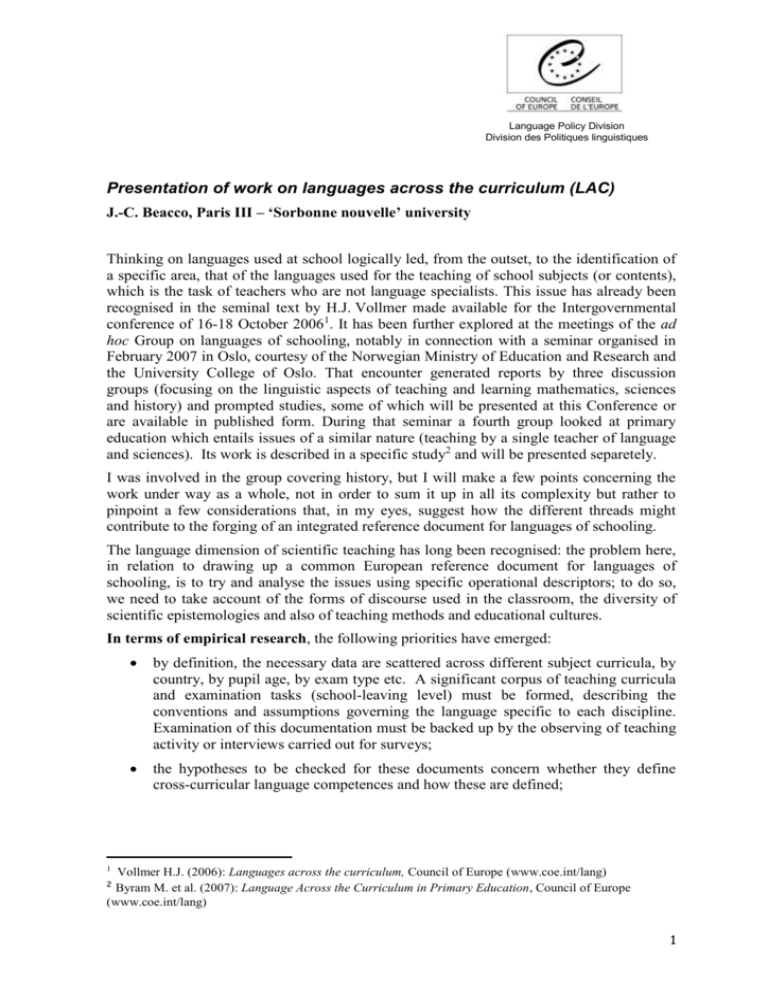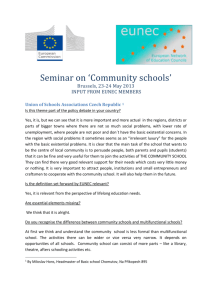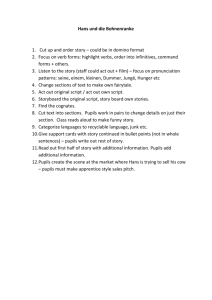Preliminary essential reading
advertisement

Language Policy Division Division des Politiques linguistiques Presentation of work on languages across the curriculum (LAC) J.-C. Beacco, Paris III – ‘Sorbonne nouvelle’ university Thinking on languages used at school logically led, from the outset, to the identification of a specific area, that of the languages used for the teaching of school subjects (or contents), which is the task of teachers who are not language specialists. This issue has already been recognised in the seminal text by H.J. Vollmer made available for the Intergovernmental conference of 16-18 October 20061. It has been further explored at the meetings of the ad hoc Group on languages of schooling, notably in connection with a seminar organised in February 2007 in Oslo, courtesy of the Norwegian Ministry of Education and Research and the University College of Oslo. That encounter generated reports by three discussion groups (focusing on the linguistic aspects of teaching and learning mathematics, sciences and history) and prompted studies, some of which will be presented at this Conference or are available in published form. During that seminar a fourth group looked at primary education which entails issues of a similar nature (teaching by a single teacher of language and sciences). Its work is described in a specific study2 and will be presented separetely. I was involved in the group covering history, but I will make a few points concerning the work under way as a whole, not in order to sum it up in all its complexity but rather to pinpoint a few considerations that, in my eyes, suggest how the different threads might contribute to the forging of an integrated reference document for languages of schooling. The language dimension of scientific teaching has long been recognised: the problem here, in relation to drawing up a common European reference document for languages of schooling, is to try and analyse the issues using specific operational descriptors; to do so, we need to take account of the forms of discourse used in the classroom, the diversity of scientific epistemologies and also of teaching methods and educational cultures. In terms of empirical research, the following priorities have emerged: by definition, the necessary data are scattered across different subject curricula, by country, by pupil age, by exam type etc. A significant corpus of teaching curricula and examination tasks (school-leaving level) must be formed, describing the conventions and assumptions governing the language specific to each discipline. Examination of this documentation must be backed up by the observing of teaching activity or interviews carried out for surveys; the hypotheses to be checked for these documents concern whether they define cross-curricular language competences and how these are defined; 1 Vollmer H.J. (2006): Languages across the curriculum, Council of Europe (www.coe.int/lang) Byram M. et al. (2007): Language Across the Curriculum in Primary Education, Council of Europe (www.coe.int/lang) 2 1 there must also be a focus on how these teachers are prepared for managing their language responsibilities within their subject teaching (during initial and in-service training), as this certainly entails important specific needs. In terms of initial provisional observations on the training of pupils, the following has been noted: a tendency within certain curricula not to restrict teaching to the content/knowledge to be passed on but to focus on an initiation in the functioning of science and in particular on the building of knowledge from a sociology of sciences perspective or a more epistemological viewpoint; the presence of objectives relating to the role and impact of sciences in life in society, often connected to education for citizenship (concerning sustainable development for example); the presence of tasks and activities for pupils geared to the use of knowledge and skills taught in given social situations. These trends underline the importance of educational goals, other than the expected cognitive outcomes, (development of thinking and conceptualisation) such as developing critical assessment of the use of scientific results. In terms of drawing up a reference document for the uses of language in the teaching of subject content, the following points emerged: despite the cross-curricular nature of language in teaching content, that use varies according to the subject. By way of an initial approximation, we could state that: - mathematics seem abstract in the extreme and have a language (or languages) of their own; - for the "exact" sciences, language serves above all to convey and discuss hypotheses and results, as the existence of products of scientific activity is established beyond their expression in language (measurements, observations etc); - for "social" or "human" sciences, language is their very form of existence, as history does not exist as such outside the realms of its expression in language; the major presence of modes of semiotic communication in addition to verbal language and, therefore, the need to examine their specific characteristics, interrelations and connections with speech; the need to establish shared terminology placing stronger emphasis on the discourse aspects (forms of speech present in the classroom and not solely spelling, morphosyntactic correction or accuracy of vocabulary); within subject teaching, it must be checked whether primary scientific language (= intended for members of the scientific community) is present and in what circumstances; forms of language transposing concepts or putting them in more accessible terms are likely to be found, and the recurrent features of teacher's statements for example (how are definitions or explanations given) or of textbook material (how is it sought to make the text readable and comprehensible for pupils) must be characterised; 2 the language competences expected are differentiated, as they hinge on the ability to interpret different forms of discourse: scientific language (in its more accessible form), forms of interaction in the classroom (teachers-pupils, inter-pupil), types of description, demonstration and argumentation etc. Interaction in these teaching activities is not all centred on scientific language; while it is relatively easy to identify activities of written comprehension (reading of textbooks etc) or oral comprehension (statements by the teacher), identifying those relating to oral production is less straightforward: they depend (doubtless with the exception of mathematics) on didactic choices made fairly independently of scientific language as a whole (considered beyond the reach of pupils in production mode) and may well come down to indistinct text forms unrelated to any kind of socially attested forms of discourse. This relative lack of generic determination is likely to lead to methodological ambiguities and therefore have ramifications for the description of tasks to be carried out by the pupils and their assessment: in this case, the pupils do not have a sufficiently precise model for the texts to be produced. This hypothesis should be checked empirically for both the oral and written production expected of pupils, which may be more closely geared in some cases to reference scientific language or disclosure. Whatever the case, it is important that pupils are taught to distinguish the norms, constraints and culturally variable types of discourse generated by science activity (and the communities which discuss it) from those used to convey this information in the classroom; this highlights the relevance of the notion of discourse genre, none too familiar to subject teachers, whose teaching may be effective in terms of linguistic competence (within the meaning of the CEFR, 5.2) and scientific terminology but are not necessarily prepared for helping pupils learn the necessary forms of discourse. Such thinking is an indication that, on the whole, the question of the aims and practice of language teaching within subject areas is still a basic concern that has not yet fully found its modus operandi and for which co-operation between the member states is indispensable. But it has been possible to identify avenues, in the form of research and experiments conducted in this field, which may lead to the full development of effective engineering tools and teaching methodologies. 3


![afl_mat[1]](http://s2.studylib.net/store/data/005387843_1-8371eaaba182de7da429cb4369cd28fc-300x300.png)





